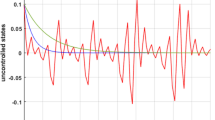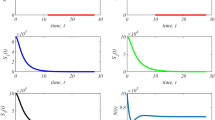Abstract
The treatment of brain tumors by chemotherapy through the controlled rate of drug has been a challenging task since long. Two nonlinear control algorithms: 1) synergetic 2) backstepping based controllers have been designed for the therapeutic agent in an updated mathematical model of brain tumor to reduce the tumor cells, to maintain a safe amount of healthy cells, to keep the immune cells above a certain value and ensure a suitable amount of drug during the therapy. Lyapunov stability theory has been used to analyze the system’s asymptotic stability and convergence of the tumor cells to their desired reference. Simulations have been performed in ODE45-Solver of Matlab/Simulink which show that chemotherapy using proposed controllers is effective enough to get the desired objectives.
Similar content being viewed by others
References
L. G. De Pillis and A. Radunskaya, “The dynamics of an optimally controlled tumor model: A case study,” Mathematical and computer modelling, vol. 37, no. 11, pp. 1221–1244, 2003.
A. El-Gohary, “Chaos and optimal control of equilibrium states of tumor system with drug,” Chaos, Solitons & Fractals, vol. 41, no. 1, pp. 425–435, Jul 2009.
S. Alavi, J. Norabadi, and M. Arjmand, “Optimal control brain tumor system with drog and uts stability,” J. Math. Computer Sci., vol. 4, no. 3, pp. 473–486, Apr. 2012.
T. Halkin, “Brain tumor facts & figures,” Incidence, Mortality, and Survival in 2018, https://blog.braintumor.org/brain-tumor-facts-figures-may-2018-incidence-mortality-and-survival-in-2018/ (accessed Jul. 29, 2019).
“Brain Tumors,” MAYFIELD Brain and Spine, https://www.mayfieldclinic.com (accessed Jul. 29, 2019).
M. Itik, M. U. Salamci, and S. P. Banks, “Optimal control of drug therapy in cancer treatment,” Nonlinear Analysis: Theory, Methods & Applications, vol. 71, no. 12, pp. e1473–e1486, Dec. 2009.
R. S. Butt, I. Ahmad and M. Arsalan, “Integral backstepping and synergetic control for tracking of infected cells during early antiretroviral therapy,” IEEE Access, vol. 7, pp. 69447–69455, 2019.
J. Liu, Y. Yu, Q. Wang, and C. Sun, “Robust distributed consensus tracking control for high-order uncertain nonlinear mass with directed topologies,” Asian Journal of Control, vol. 22, no. 6, pp. 2558–2568, 2020.
J. Liu, Y. Zhang, Y. Yu, and C. Sun, “Fixed-time event-triggered consensus for nonlinear multiagent systems without continuous communications,” IEEE Trans. Syst. Man Cybern, Syst., vol. 49, no. 11, pp. 2221–2229, Nov. 2019.
Y. Fang, J. Fei, and Y. Yang, “Adaptive backstepping design of a microgyroscope,” Micromachines, vol. 9, no. 7, pp. 338, Jul 2018.
A. Boonyaprapasorn, P. S. Ngiamsunthorn, and T. Sethaput, “Synergetic control for HIV infection system of CD4+T cells,” Proc. of 16th International Conference on Control in Automation and Systems (ICCAS), pp. 484–488, Oct. 2016.
M. Cupelli, M. Moghimi, A. Riccobono, and A. Monti, “A comparison between synergetic control and feedback linearization for stabilizing MVDC microgrids with constant power load,” IEEE PES Innovative Smart Grid Technologies, vol. 9, no. 7, pp. 1–6, Oct. 2014.
“Most Popular Disease,” Bluecircle, http://www.kc.bluecircle.in (accessed Jul. 29, 2019).
P. A. Valle, K. E. Starkov, and L. N. Coria, “Global stability and tumor clearance conditions for a cancer chemotherapy system,” Communications in Nonlinear Science and Numerical Simulation, vol. 40, pp. 206–215, Nov 2016.
E. Hossain, R. Perez, S. Padmanaban, L. Mihet-Popa, F. Blaabjerg, and V. Ramachandaramurthy, “Sliding mode controller and Lyapunov redesign controller to improve microgrid stability: A comparative analysis with CPL power variation,” Energies, vol. 10, no. 12, p. 1959, Nov. 2017.
A. A. Kolesnikov, “Introduction of synergetic control,” Proc. of American Control Conference, pp. 3013–3016, 2014.
A. Bezuglov, A. Kolesnikov, I. Kondratiev, and J. Vargas, “Synergetic control theory approach for solving systems of nonlinear equations,” Proc. of the 9th World MultiConference on Systemics, Cybernetics and Informatics, pp. 121–126, 2005.
Author information
Authors and Affiliations
Corresponding author
Additional information
Muhammad Zubair received his M.S. degree in electrical engineering from the School of Electrical Engineering and Computer Science (SEECS), National university of Science and Technology (NUST), Islamabad, Pakistan. His current research interests include nonlinear control applications, power converters, nonlinear control of biomedical systems, and hybrid electric vehicles.
Iftikhar Ahmad Rana is serving as an Assistant Professor at the Department of Electrical Engineering, School of Electrical Engineering, and Computer Science, National University of Sciences and Technology (NUST), Islamabad, Pakistan. Earlier, he received an M.S. degree in fluid mechanical engineering from University Paris VI (University Pierre Marie Curie, Paris) and his Ph.D. in robotics, control and automation, from the Universite de Versailles France.
Yasir Islam received his B.S. and M.S. degrees in electrical engineering with specialization in power and control systems from School of Electrical Engineering and Computer Science, National University of Sciences and Technology (NUST), Islamabad, Pakistan.
Publisher’s Note
Springer Nature remains neutral with regard to jurisdictional claims in published maps and institutional affiliations.
Rights and permissions
About this article
Cite this article
Zubair, M., Ahmad, I. & Islam, Y. Backstepping and Synergetic Controllers for the Chemotherapy of Brain Tumor. Int. J. Control Autom. Syst. 19, 2544–2556 (2021). https://doi.org/10.1007/s12555-020-0426-5
Received:
Revised:
Accepted:
Published:
Issue Date:
DOI: https://doi.org/10.1007/s12555-020-0426-5




